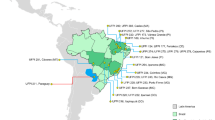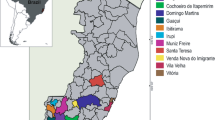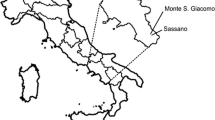Abstract
Tepary bean (Phaseolus acutifolius A. Gray) is a dry-land crop species that originated in the deserts of Mexico and the south-western United States and therefore is proposed as a source of drought and salt tolerance for related species and for production in marginal rainfall areas. Few genetic tools have been developed or tested for tepary bean but microsatellites from common bean are an obvious choice for diversity analysis in the crop. The first goal of this study was to validate a set of gene-derived and non-gene simple sequence repeat or microsatellite markers from common bean in tepary bean cultivars and wild relative accessions. The second and more extensive objective of this study was to evaluate the genetic diversity and population structure of the tepary bean accessions to determine if leaf-morphology variants are valid as separate sub-groups of wild tepary beans; if P. parvifolius exist as a separate variants or species; and if cultivated tepary beans originated from one domestication event or several events. Our analysis of 140 tepary bean genotypes showed that a single domestication was likely as the cultivars were most closely related to accessions from Sinaloa and northern Mexico and that diversity was much higher in the wild genotypes compared to the cultivated ones. Other results were that P. parvifolius was classified as a separate species by population structure analysis while the variants P. acutifolius var. acutifolius and var. tenuifolius were admixed and inter-crossed. P. latifolius is not a valid species or variant of P. acutifolius but represents a group of cultivars within tepary bean. This is the first analysis of microsatellite diversity in tepary beans and has implications for breeding and conservation of this crop and its wild relatives.



Similar content being viewed by others

References
Afanador LK, Haley SD, Kelly JD (1993) Adoption of a “mini-prep” DNA extraction method for RAPD marker analysis in common bean (Phaseolus vulgaris L.). Ann Rep Bean Improv Coop 36:10–11
Baudet JC (1977) Origine et classification des espèces cultivèes du genre Phaseolus. Bull Soc Roy Bot Belg 110:65–76
Blair MW, Muñoz LC, Debouck D (2002) Tepary beans (P. acutifolius): molecular analysis of a forgotten genetic resource for dry land agriculture. Grain Legum 36:25–26
Blair MW, Pedraza F, Buendía HF, Gaitán-Solís E, Beebe SE, Gepts P, Tohme J (2003a) Development of a genome-wide anchored microsatellite map for common bean (Phaseolus vulgaris L.). Theor Appl Genet 107:1362–1374
Blair MW, Pantoja W, Muñoz LC, Hincapie A (2003b) Genetic analysis of crosses between cultivated tepary bean and wild Phaseolus acutifolius and P. parvifolius. Ann Rep Bean Improv Coop 46:27–29
Blair MW, Giraldo MC, Buendia HF, Tovar E, Duque MC, Beebe SE (2006) Microsatellite marker diversity in common bean (Phaseolus vulgaris L.). Theor Appl Genet 113:100–109
Blair MW, Díaz JM, Hidalgo R, Díaz LM, Duque MC (2007) Microsatellite characterization of Andean races of common bean (Phaseolus vulgaris L.). Theor Appl Genet 116:29–43
Blair MW, Muñoz-Torres M, Giraldo MC, Pedraza F (2009) Development and diversity assessment of Andean-derived, gene-based microsatellites for common bean (Phaseolus vulgaris L.). BMC Plant Bio 9:100
Buhrow R (1983) The wild beans of southwestern North America. Desert Plants 5:67–88
Carter GF (1945) Plant geography and culture history in the American southwest. Viking Fund Publication in Anthropology, #5
Coyne DP, Schuster ML, Al-Yasiri S (1963) Reaction studies of bean species and varieties to common blight and bacterial wilt. Plant Dis Rep 47:534–537
Debouck DG (1991) Systematics and morphology. In: Schoonhoven AV, Voysest O (eds) Common beans: research for crop improvement. CABI, Wallingford, pp 55–118
Debouck DG (1999) Diversity in Phaseolus species in relation to the common bean. In: Singh SP (ed) Kluwer Academic Publishers. Holland, Dordrecht, pp 25–52
Debouck DG, Smartt J (1995) Beans Phaseolus spp. (Leguminosae–Papilionoideae). In: Smartt J, Simmonds NW (eds) Evolution of crop plants, 2nd edn. Longman, Harlow, pp 287–294
Delgado SA (1985) Systematics of the genus Phaseolus (Leguminoseae) in North and Central America. Ph.D. Thesis, University of Texas, Austin, TX, USA
Díaz LM, Blair MW (2006) Race structure within the Mesoamerican gene pool of common bean (Phaseolus vulgaris L.) as determined by microsatellite markers. Theor Appl Genet 114:143–154
Florez CP, Ocampo CH, Toro O (2003) A biochemical trait helps to recognize Phaseolus parvifolius Freytag in the gene pool of tepary bean. Ann Rep Bean Improv Coop 46:23–24
Freeman GF (1912) Southwestern beans and teparies. Bull Univ Ariz Agric Exp Stn 68:1–55
Freeman GF (1913) The tepary, a new cultivated legume from the Southwest. Bot Gaz (Chicago) 56:395–417
Freytag GF, Debouck DG (2002) Taxonomy, distribution, and ecology of the genus Phaseolus (Leguminosae-Papilionoideae) in North America, Mexico and Central America. SIDA Bot Misc 23:1–300
Freytag G, Debouck DG (2003) Taxonomy, distribution, and ecology of the genus Phaseolus (Leguminosae–Papilionoideae) in North America, Mexico and Central America. Botanical Miscellany No. 23
Gaitán-Solís E, Duque MC, Edwards KJ, Tohme J (2002) Microsatellite repeats in common bean (Phaseolus vulgaris): isolation, characterization, and cross-species amplification in Phaseolus ssp. Crop Sci 42:2128–2136
Garvin DF, Weeden NF (1994) Isozyme evidence supporting a single geographic origin for domesticated tepary bean. Crop Sci 34:1390–1395
Hanai LR, Santini L, Aranha LEC, Pelegrinelli MHF, Gepts P, Tsai SM, Carneiro ML (2010) Extension of the core map of common bean with EST-SSR, RGA, AFLP, and putative functional markers. Mol Breeding 25:25–45
Kaplan L (1967) Archaeological Phaseolus from Tehuacan. In: Byers DS (ed) The prehistory of the Tehuacan valley, vol 1. University of Texas Press, Austin, pp 201–211
Kaplan L, Lynch TF (1999) Phaseolus (Fabaceae) in archaeology: AMS radiocarbon dates and their significance for pre-Colombian agriculture. Econ Bot 53:261–272
Liu K, Muse SVB (2005) PowerMarker: integrated analysis environment for genetic marker data. Bioinformatics 21:2128–2129
Manshardt RM, Waines JG (1983) Isozyme variation and the origin of domesticated tepary bean. Ann Rep Bean Improv Coop 26:18–19
Maréchal R, Mascherpa JM, Stainier F (1978) Etude taxonomique d’un groupe complexe d’especes des genres Phaseolus et Vigna (Papilionaceae) sur la base des donnees morphologiques et polliniques traitees par l’analyse informatique. Boissiera 28:1–273
Micheletto S, Rodriguez L, Hernandez R, Richins R, Curry J, O’Connell M (2007) Comparative transcript profiling in roots of Phaseolus acutifolius and P. vulgaris under water deficit stress. Plant Sci 173:510–520
Miklas PN, Santiago J (1996) Reaction of select tepary bean to bean golden mosaic virus. HortSci 31:430–432
Miklas PN, Schwartz HF, Salgado MO, Nina R, Beaver JS (1998) Reaction of select tepary bean to ashy stem blight and Fusarium wilt. HortSci 33:136–139
Muñoz LC, Blair MW, Duque MC, Tohme J, Roca W (2004) Introgression in common bean x tepary bean interspecific congruity-backcross lines as measured by AFLP markers. Crop Sci 44:637–645
Muñoz C, Duque MC, Debouck D, Blair MW (2006) Taxonomy of tepary bean (Phaseolus acutifolius) and wild relatives as determined by amplified fragment length polymorphism (AFLP) markers. Crop Sci 46:1744–1754
Nabhan GP, Felger RS (1978) Teparies in southwestern North America. Econ Bot 32:3–19
Perrier X, Flori A, Bonnot F (2003) Data analysis methods. In: Hamon P, Seguin M, Perrier X, Glaszmann JC (eds) Genetic diversity of cultivated tropical plants. Enfield Science Publishers, Montpellier, pp 43–76
Pratt RC, Nabhan GP (1988) Evolution and diversity of Phaseolus acutifolius genetic resources. In: Gepts P (ed) Genetic resources of Phaseolus beans. Kluwer Academic Publishers, Holland, pp 309–440
Pritchard JK, Stephens M, Donnelly P (2000) Inference of population structure using multilocus genotype data. Genetics 155:945–959
Schinkel C, Gepts P (1988) Phaseolin diversity in the tepary bean Phaseolus acutifolius A. Gray. Plant Breed 101:292–301
Schinkel C, Gepts P (1989) Allosyme variability in the tepary bean, Phaseolus acutifolius A. Gray. Plant Breed 102:182–195
Singh SP, Debouck DG, Roca WM (1998) Interspecific hybridization between Phaseolus vulgaris L. and P. parvifolius Freytag. Ann Rep Bean Improv Coop 41:7–8
Vavilov NI (1931) Mexico and Central America as the principal centre of origin of cultivated plants of the New World. Bull. Appl Bot 26:179–199
Yu K, Park SJ, Poysa V, Gepts P (2000) Integration of simple sequence repeat (SSR) markers into a molecular linkage map of common bean (Phaseolus vulgaris L.). J Hered 91:429–434
Zambre M, Goossens A, Cardona C, Van Montagu M, Terryn N et al (2005) A reproducible genetic transformation system for cultivated Phaseolus acutifolius (tepary bean) and its use to assess the role of arcelins in resistance to the Mexican bean weevil. Theor Appl Genet 110:914–924
Acknowledgments
We thank Lucy M. Díaz for technical help with software analysis, Daniel Debouck of the bean gene bank for his helpful advice on the accessions analyzed in this study; Orlando Toro and the group at the Genetic Resources Unit for providing seed; and Agobardo Hoyos, Alcides Hincapie and Guillermo Ortíz for growing genotypes for DNA extraction. The writing of this paper was supported by the IAEA grant on tepary bean improvement and by the National University of Colombia.
Author information
Authors and Affiliations
Corresponding author
Additional information
Communicated by B. Diers.
Rights and permissions
About this article
Cite this article
Blair, M.W., Pantoja, W. & Carmenza Muñoz, L. First use of microsatellite markers in a large collection of cultivated and wild accessions of tepary bean (Phaseolus acutifolius A. Gray). Theor Appl Genet 125, 1137–1147 (2012). https://doi.org/10.1007/s00122-012-1900-0
Received:
Accepted:
Published:
Issue Date:
DOI: https://doi.org/10.1007/s00122-012-1900-0



